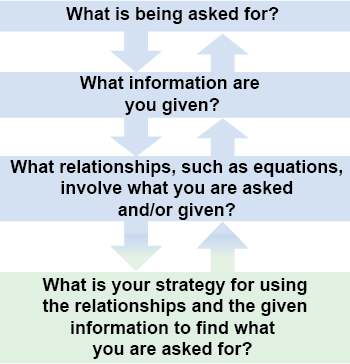|
 How do you start solving a physics problem? The technique on this page has four steps and will always get you started or even most of the way toward solving a problem:
How do you start solving a physics problem? The technique on this page has four steps and will always get you started or even most of the way toward solving a problem: - Asked: Determine what the problem is asking you for.
- Given: Determine what information you are given.
- Relationships: Write down the relationships you know that involve what is asked and what is given.
- Solution: Use the relationships and the given information to solve the problem.

 |
Whenever you have finished solving a problem, it is always recommended to check over your solution and make sure that the answer makes sense. If you are asked to estimate the mass of an ant, and your solution results in an answer of 3,467 kg, then the answer is not reasonable! Check your work both for mistakes and for reasonableness. 
|
Determine what the problem is asking for. Be very specific. For example, when a problem asks how far an object has moved, the answer is a distance. It is easy to get sidetracked by looking for things you do not need, so read the problem carefully—twice, or as many times as you need—to make sure you understand what the problem is asking. Assign variables to the unknowns. For example, if the problem asks for a speed, the unknown is represented by the variable v. If there are two unknown speeds, then assign them variables v1 and v2. 
|
Identify all the information you are given in the problem. Information may be in the form of measurements, such as mass or length. Information may also be descriptive. For example, “at rest” means something is not moving and has a speed of zero. Some information may also be deduced from other information. For example, if an object is not moving, then the net force acting on it must be zero. If the net force were not zero, then the object would be accelerating and could not stay still. Assign variables to the given quantities. For example, if you are given a mass, then assign it the variable m. If there are two given masses, then assign them variables m1 and m2. 
|
Identify relationships, such as equations, that involve what you need to know and/or the information you are given. For example, if you want to know speed and are given distance and time, then you would write down the formula for speed that includes distance and time. Some problems require more than one relationship. 
|
Apply the given information and relationships to solve the problem. Once you have collected the information and the relationships, you will often see how the problem can be solved. Sometimes the solution may require more than one step; you might use force to calculate acceleration, and then use acceleration to calculate speed. 
|
No matter how much you read about how to solve problems you will not become good at it until you start solving them. You can only learn how to solve problems by solving many of them. Don’t worry if you make mistakes. Just keep on trying! 
|
In the problem “How fast is a man running if he can cover 10 m in 2 s?” what is being asked for? - distance
- speed
- acceleration
- time
 |
The correct answer is b, speed. “How fast” refers to speed or velocity. 
|

